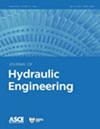求助PDF
{"title":"低资源环境下估算河流流量的单点流速测量方法的改进","authors":"Ghadeer Ali, M. Maghrebi","doi":"10.1061/jhend8.hyeng-13469","DOIUrl":null,"url":null,"abstract":": Accurate and reliable river discharge evaluation at a river station is an essential piece of information to obtain. This work modifies a power-law (PL)-based model and a single point velocity measurement (SPM) method for calculating channel discharge. Specifically, modifications are proposed for the constant shear velocity assumption, water surface effects, the underlying velocity distribution, and the number of measurements. A coefficient of water surface ( cw ) is proposed to consider the impact of water surface on distribution of velocity. Additionally, a power-wake-law (PWL) method is proposed to cope with the velocity dip phenomenon, where the maximum velocity occurs below the water surface. A critical assessment of the performance of the modifications using laboratory and field data is introduced. A trial-and-error procedure is applied to the laboratory data to obtain the value of the proposed coefficient cw and the parameters of PWL velocity distribution, α and β . It is found that cw ¼ 0 . 3 , α ¼ 1 . 5 = m, and β ¼ 0 . 6 are the most appropriate values that produce minimum errors in most cases. A combination approach is applied to the field data to demonstrate the performance of the modifications and the impact of increasing the number of measurements. It is found that considering a water surface effect has significantly improved the accuracy. Also, it is found that the modified PL-and PWL-based models can estimate discharge with a reasonable accuracy using five measured velocimetry points in most tested cross-sections. In most studied rivers, the five-point combinations reduce the mean absolute percentage error (MAPE) value to less than 5%. DOI: 10.1061/JHEND8.HYENG-13469. © 2023 American Society of Civil Engineers.","PeriodicalId":16046,"journal":{"name":"Journal of Hydraulic Engineering","volume":" ","pages":""},"PeriodicalIF":2.1000,"publicationDate":"2023-11-01","publicationTypes":"Journal Article","fieldsOfStudy":null,"isOpenAccess":false,"openAccessPdf":"","citationCount":"0","resultStr":"{\"title\":\"Modifications to the Single Point Velocity Measurement Method for Estimating River Discharge in Low-Resource Environments\",\"authors\":\"Ghadeer Ali, M. Maghrebi\",\"doi\":\"10.1061/jhend8.hyeng-13469\",\"DOIUrl\":null,\"url\":null,\"abstract\":\": Accurate and reliable river discharge evaluation at a river station is an essential piece of information to obtain. This work modifies a power-law (PL)-based model and a single point velocity measurement (SPM) method for calculating channel discharge. Specifically, modifications are proposed for the constant shear velocity assumption, water surface effects, the underlying velocity distribution, and the number of measurements. A coefficient of water surface ( cw ) is proposed to consider the impact of water surface on distribution of velocity. Additionally, a power-wake-law (PWL) method is proposed to cope with the velocity dip phenomenon, where the maximum velocity occurs below the water surface. A critical assessment of the performance of the modifications using laboratory and field data is introduced. A trial-and-error procedure is applied to the laboratory data to obtain the value of the proposed coefficient cw and the parameters of PWL velocity distribution, α and β . It is found that cw ¼ 0 . 3 , α ¼ 1 . 5 = m, and β ¼ 0 . 6 are the most appropriate values that produce minimum errors in most cases. A combination approach is applied to the field data to demonstrate the performance of the modifications and the impact of increasing the number of measurements. It is found that considering a water surface effect has significantly improved the accuracy. Also, it is found that the modified PL-and PWL-based models can estimate discharge with a reasonable accuracy using five measured velocimetry points in most tested cross-sections. In most studied rivers, the five-point combinations reduce the mean absolute percentage error (MAPE) value to less than 5%. DOI: 10.1061/JHEND8.HYENG-13469. © 2023 American Society of Civil Engineers.\",\"PeriodicalId\":16046,\"journal\":{\"name\":\"Journal of Hydraulic Engineering\",\"volume\":\" \",\"pages\":\"\"},\"PeriodicalIF\":2.1000,\"publicationDate\":\"2023-11-01\",\"publicationTypes\":\"Journal Article\",\"fieldsOfStudy\":null,\"isOpenAccess\":false,\"openAccessPdf\":\"\",\"citationCount\":\"0\",\"resultStr\":null,\"platform\":\"Semanticscholar\",\"paperid\":null,\"PeriodicalName\":\"Journal of Hydraulic Engineering\",\"FirstCategoryId\":\"5\",\"ListUrlMain\":\"https://doi.org/10.1061/jhend8.hyeng-13469\",\"RegionNum\":3,\"RegionCategory\":\"工程技术\",\"ArticlePicture\":[],\"TitleCN\":null,\"AbstractTextCN\":null,\"PMCID\":null,\"EPubDate\":\"\",\"PubModel\":\"\",\"JCR\":\"Q2\",\"JCRName\":\"ENGINEERING, CIVIL\",\"Score\":null,\"Total\":0}","platform":"Semanticscholar","paperid":null,"PeriodicalName":"Journal of Hydraulic Engineering","FirstCategoryId":"5","ListUrlMain":"https://doi.org/10.1061/jhend8.hyeng-13469","RegionNum":3,"RegionCategory":"工程技术","ArticlePicture":[],"TitleCN":null,"AbstractTextCN":null,"PMCID":null,"EPubDate":"","PubModel":"","JCR":"Q2","JCRName":"ENGINEERING, CIVIL","Score":null,"Total":0}
引用次数: 0
引用
批量引用
Modifications to the Single Point Velocity Measurement Method for Estimating River Discharge in Low-Resource Environments
: Accurate and reliable river discharge evaluation at a river station is an essential piece of information to obtain. This work modifies a power-law (PL)-based model and a single point velocity measurement (SPM) method for calculating channel discharge. Specifically, modifications are proposed for the constant shear velocity assumption, water surface effects, the underlying velocity distribution, and the number of measurements. A coefficient of water surface ( cw ) is proposed to consider the impact of water surface on distribution of velocity. Additionally, a power-wake-law (PWL) method is proposed to cope with the velocity dip phenomenon, where the maximum velocity occurs below the water surface. A critical assessment of the performance of the modifications using laboratory and field data is introduced. A trial-and-error procedure is applied to the laboratory data to obtain the value of the proposed coefficient cw and the parameters of PWL velocity distribution, α and β . It is found that cw ¼ 0 . 3 , α ¼ 1 . 5 = m, and β ¼ 0 . 6 are the most appropriate values that produce minimum errors in most cases. A combination approach is applied to the field data to demonstrate the performance of the modifications and the impact of increasing the number of measurements. It is found that considering a water surface effect has significantly improved the accuracy. Also, it is found that the modified PL-and PWL-based models can estimate discharge with a reasonable accuracy using five measured velocimetry points in most tested cross-sections. In most studied rivers, the five-point combinations reduce the mean absolute percentage error (MAPE) value to less than 5%. DOI: 10.1061/JHEND8.HYENG-13469. © 2023 American Society of Civil Engineers.


